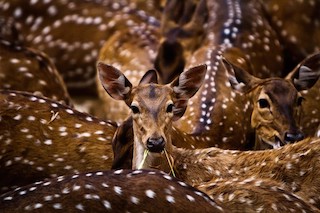🌎 Ecology Basics
Fundamental of Ecology

- Ecology means interaction between community & abiotic environment.
“Ecology is the scientific study of the relation of living organisms with each other and their surrounding or non-living components of environment.”
- The term ecology was proposed by
Reiter. - Living organisms:
- Plants
- Animals
- Microorganisms is soil etc.
- Non-living components of environment:
- Light
- Water
- Wind
- Nutrients in soil
- Heat
- Solar radiation
- Atmosphere, etc.
- Community: All the populations of the different species living and interacting in the same ecosystem.
- Habitat: The characteristics of the type of environment where an organism normally lives.
- Ecosystem: Bounded ecological system consisting of all the consisting organisms in an area and in the physical environment with which they interact.
- The word ecosystem coined by
A.G. Tansley.
Ecosystem Components
Producers
- Mainly vegetation
Consumer
- Heterotrophs: Feed on producer or consumers.
- Herbivores:
- Plant eaters
- Primary consumers
- Carnivores:
- Meat eaters
- Secondary (tertiary) consumers
- Omnivores:
- Eat both plant & animals
- Herbivores:
Decomposers
- Break down dead organic matter & wastes.
- Saprophytes:
- Mostly bacteria & fungi.
- Detritivores:
- Feed on partially decomposed matter
- E.g. crabs, termites, worms
- Scavengers:
- E.g. vultures, crows, lobsters
Food chain
- In an ecosystem, the sequential chain of eating and being eaten is called a food chain.
- Food chains consist of producers, consumers, and decomposers.
- The majority of consumers and decomposers can be included in more than one food chain.
- All animals require energy, which is procured from food, to function. A food chain describes how animals get energy. Animals are not capable of producing their own food.
Food web
- Food webs show how plants and animals are connected in many ways to help them all survive. The set of interrelated food chains is a food web.
Niche
- An organism’s habitat + role + tolerance limits to all limiting factors.
- The niche of a species consists of:
- Its role in the ecosystem (herbivore, carnivore, producer etc.).
- Its tolerance limits (e.g. soil, pH, humidity).
- Its requirements for shelter, nesting sites etc, all varying through time.
- Food chain pyramid like pond, forest etc.
- National Biodiversity
Board-New Delhi - National Biodiversity
Authority–Chennai - Red data book is famous for Endangered animals and Plants. IBPS AFO 2012
- Law of Tolerance –
Sheford - A law stating that the abundance or distribution of an organism can be controlled by certain factors (e.g. the climatic, topographic, and biological requirements of plants and animals) where levels of these exceed the maximum or minimum limits of tolerance of that organism.
Explore More 🔭
🟢 https://youtu.be/hmI-rJuYAjw 🟢 https://youtu.be/spTWwqVP_2s 🟢 https://youtu.be/GK_vRtHJZu4 https://youtu.be/fHztd6k5ZXY

- Ecology means interaction between community & abiotic environment.
“Ecology is the scientific study of the relation of living organisms with each other and their surrounding or non-living components of environment.”
- The term ecology was proposed by
Reiter. - Living organisms:
- Plants
- Animals
- Microorganisms is soil etc.
- Non-living components of environment:
- Light
- Water
- Wind
- Nutrients in soil
- Heat
- Solar radiation
- Atmosphere, etc.
- Community: All the populations of the different species living and interacting in the same ecosystem.
- Habitat: The characteristics of the type of environment where an organism normally lives.
- Ecosystem: Bounded ecological system consisting of all the consisting organisms in an area and in the physical environment with which they interact.
- The word …
Become Successful With AgriDots
Learn the essential skills for getting a seat in the Exam with
🦄 You are a pro member!
Only use this page if purchasing a gift or enterprise account
Plan
Rs
- Unlimited access to PRO courses
- Quizzes with hand-picked meme prizes
- Invite to private Discord chat
- Free Sticker emailed
Lifetime
Rs
1,499
once
- All PRO-tier benefits
- Single payment, lifetime access
- 4,200 bonus xp points
- Next Level
T-shirt shipped worldwide

Yo! You just found a 20% discount using 👉 EASTEREGG

High-quality fitted cotton shirt produced by Next Level Apparel